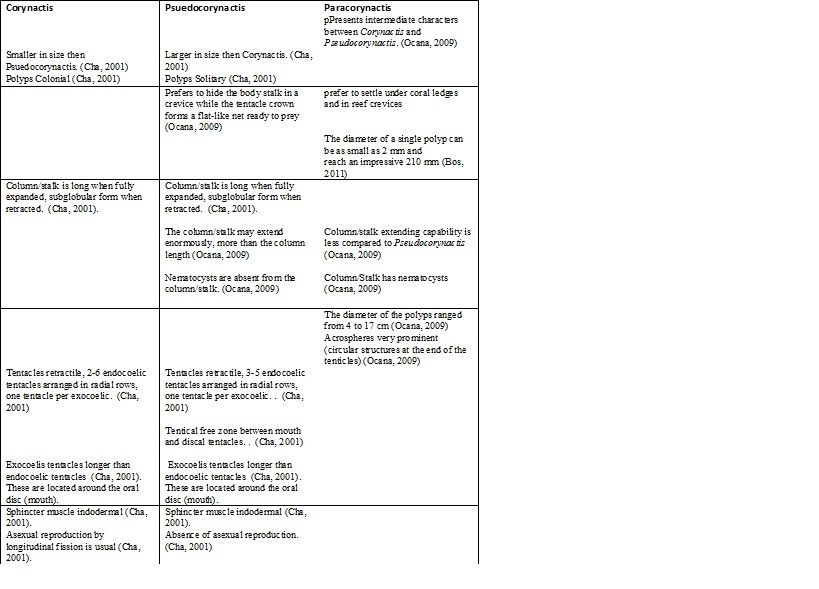Oxylebius
Well-Known Member
There are many web sites that are listing false information on identifying a small anemone hitchhicker and so I would like to share some information that I have researched.
I welcome comments and questions. I am also open to learning more, so if you are able to add to what I posted below, that would be great.
The debate continues in academia differentiating among the genera of the Corallimorphidae family, which includes the genera Corynactis, Pseudocorynactis, Corallimorphus, Neactis, Sideractis, and Paracorynactis. Reclassification occurs every few years or so it seems.
The anemones I have in my tank are small, solitary, have red/pink starks, white mouths, tentacles are transparent/clear and have white balls on tips. Side note: it doesn't have a solid calcium base, so it isn't a cup coral (Cladocora or stony coral).
Some basic general differences of Pseudocorynactis is its large size and solitary habit.
Corynactis is restricted to temperate waters (cold waters) with the exception of C. parvula that can colonize some tropical environments. Pseudocorynactis and Paracorynactis are tropical-subtropical genera. (Ocana, 2009)
So, that leaves us w/only a few species that are finding their way into our tanks hitchhiking on rocks. These I list below.
Three species of Pseudocorynactis: P. caribbeorum, P. caboverdnesis, P. tuberculata.
One species of Corynactis: C. parvula
Two species of Paracorynactis: P. hoplites, (possibly P. globulifera)
(Note: I guess there is some discussion that P. caboverdnesis and C. parvula need more research and could possibly be the same species, which might explain why C. parvula is the only warm water Corynactis species when all others are cold water. I highlight this one in particular b/c there are some websites that wrongly ID Corynactis species using a Pseudocorynactis photo with it.)
Some Characteristics that I pulled from publications are listed below. These should help to define the differences of the species, but some are anatomical and can only be determined by microscope (this is unfortunate for those of us who would like to ID our critters). There are also gaps in info that I haven't been able to fill-in yet. The table is laid out in rows and columns. If there is a blank space, then I wasn't able to find the info that would be equivalent to the info that is next to it in the same row (e.g. solitary vs colonial).

References:
Arthur R. Bos. 2011. FEEDING BIOLOGY AND SYMBIOTIC RELATIONSHIPS OF THE CORALLIMORPHARIAN PARACORYNACTIS HOPLITES (ANTHOZOA: HEXACORALLIA). THE RAFFLES BULLETIN OF ZOOLOGY 2011 59(2): 245–250.
O. Ocaña, J. C. den Hartog, A. Brito & A.R. Bos. 2009. ON PSEUDOCORYNACTIS SPECIES AND ANOTHER RELATED GENUS FROM THE INDO-PACIFIC (ANTHOZOA: CORALLIMORPHIDAE). Rev. Acad. Canar. Cienc., XXI (Núms. 3-4), 9-34 (2009) (publicado en septiembre de 2010).
H. Cha. 2001. Systematics of the order Corallimorpharia (Cnidaria: Anthozoa). Submitted to the Department of Ecology and Evolutionary Biology and the Faculty of the Graduate School of the University of Kansas in partial fulfillment of the requirements for the degree of Doctor of Philosophy.
I welcome comments and questions. I am also open to learning more, so if you are able to add to what I posted below, that would be great.
The debate continues in academia differentiating among the genera of the Corallimorphidae family, which includes the genera Corynactis, Pseudocorynactis, Corallimorphus, Neactis, Sideractis, and Paracorynactis. Reclassification occurs every few years or so it seems.
The anemones I have in my tank are small, solitary, have red/pink starks, white mouths, tentacles are transparent/clear and have white balls on tips. Side note: it doesn't have a solid calcium base, so it isn't a cup coral (Cladocora or stony coral).
Some basic general differences of Pseudocorynactis is its large size and solitary habit.
Corynactis is restricted to temperate waters (cold waters) with the exception of C. parvula that can colonize some tropical environments. Pseudocorynactis and Paracorynactis are tropical-subtropical genera. (Ocana, 2009)
So, that leaves us w/only a few species that are finding their way into our tanks hitchhiking on rocks. These I list below.
Three species of Pseudocorynactis: P. caribbeorum, P. caboverdnesis, P. tuberculata.
One species of Corynactis: C. parvula
Two species of Paracorynactis: P. hoplites, (possibly P. globulifera)
(Note: I guess there is some discussion that P. caboverdnesis and C. parvula need more research and could possibly be the same species, which might explain why C. parvula is the only warm water Corynactis species when all others are cold water. I highlight this one in particular b/c there are some websites that wrongly ID Corynactis species using a Pseudocorynactis photo with it.)
Some Characteristics that I pulled from publications are listed below. These should help to define the differences of the species, but some are anatomical and can only be determined by microscope (this is unfortunate for those of us who would like to ID our critters). There are also gaps in info that I haven't been able to fill-in yet. The table is laid out in rows and columns. If there is a blank space, then I wasn't able to find the info that would be equivalent to the info that is next to it in the same row (e.g. solitary vs colonial).

References:
Arthur R. Bos. 2011. FEEDING BIOLOGY AND SYMBIOTIC RELATIONSHIPS OF THE CORALLIMORPHARIAN PARACORYNACTIS HOPLITES (ANTHOZOA: HEXACORALLIA). THE RAFFLES BULLETIN OF ZOOLOGY 2011 59(2): 245–250.
O. Ocaña, J. C. den Hartog, A. Brito & A.R. Bos. 2009. ON PSEUDOCORYNACTIS SPECIES AND ANOTHER RELATED GENUS FROM THE INDO-PACIFIC (ANTHOZOA: CORALLIMORPHIDAE). Rev. Acad. Canar. Cienc., XXI (Núms. 3-4), 9-34 (2009) (publicado en septiembre de 2010).
H. Cha. 2001. Systematics of the order Corallimorpharia (Cnidaria: Anthozoa). Submitted to the Department of Ecology and Evolutionary Biology and the Faculty of the Graduate School of the University of Kansas in partial fulfillment of the requirements for the degree of Doctor of Philosophy.
